More than ten case studies were shared from various perspectives (the pre-agreed presenters and moderators in the picture below).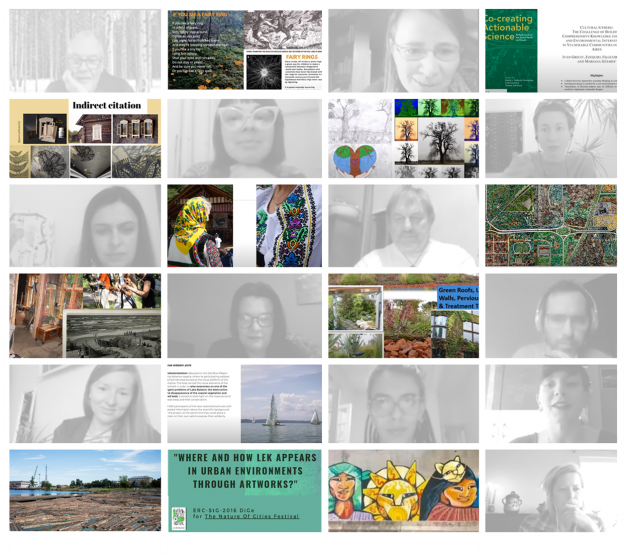 As a brief introduction, Rick Hall shared examples from the work of ignite! Julia Prakofjewa shared the concept of craftivism and direct&indirect quotation of LEK through artworks. Nataliya Stryamets brought the participants to Ukraine and the use of wild flowers during the festivities. Andra Simanova added a case study of House of Fairy tales. Eva Bubla explored how cultural initiative szabadonbalaton draws attention to the ecological needs and risks of Lake Balaton and its region, aiming to transform public awareness and practices. Another example come from Riga and contemporary art scene there, namely, Riga International Biennial of Contemporary Art, which in its recent iteration was focused on using locally produced materials when creating new artworks and re-using these materials after the end of the exhibition. One of the examples was an art installation by Lina Lapelytė and Mantas Petraitis — the use of 2,000 pine logs which formed a large scale installation in Daugava river during the exhibition and was later re-used by a local wood manufacturing factory. Anna Varga brought to the discussion a project on wood pastures, ancient trees and LEK into formal education. Colin Meurk who joined our discussion from New Zealand used key words as spontaneous urban wild during his talk on Connectivity – Symbiosis – Transcultural Partnerships. Lara Eva shared street art across Tilcara in northern Argentina which reflects the local community knowledge of the ecological processes around the area. Marthe Derkzen, from the Netherlands brought a problem driven approach, questioning how art may be applied to get people together and gain direct experience with nature (including the empowering process communities within the process). This was complemented further by Ivan Greco and Ezequiel Filgueira Risso from Red ECCCO Foundation (Buenos Aires) who shared a work of art and sustainability in slum neighborhoods as well as introduced steps of this collaborative work e.g. the application of Horacio Sanchez Fantino´s techniques.
As a brief introduction, Rick Hall shared examples from the work of ignite! Julia Prakofjewa shared the concept of craftivism and direct&indirect quotation of LEK through artworks. Nataliya Stryamets brought the participants to Ukraine and the use of wild flowers during the festivities. Andra Simanova added a case study of House of Fairy tales. Eva Bubla explored how cultural initiative szabadonbalaton draws attention to the ecological needs and risks of Lake Balaton and its region, aiming to transform public awareness and practices. Another example come from Riga and contemporary art scene there, namely, Riga International Biennial of Contemporary Art, which in its recent iteration was focused on using locally produced materials when creating new artworks and re-using these materials after the end of the exhibition. One of the examples was an art installation by Lina Lapelytė and Mantas Petraitis — the use of 2,000 pine logs which formed a large scale installation in Daugava river during the exhibition and was later re-used by a local wood manufacturing factory. Anna Varga brought to the discussion a project on wood pastures, ancient trees and LEK into formal education. Colin Meurk who joined our discussion from New Zealand used key words as spontaneous urban wild during his talk on Connectivity – Symbiosis – Transcultural Partnerships. Lara Eva shared street art across Tilcara in northern Argentina which reflects the local community knowledge of the ecological processes around the area. Marthe Derkzen, from the Netherlands brought a problem driven approach, questioning how art may be applied to get people together and gain direct experience with nature (including the empowering process communities within the process). This was complemented further by Ivan Greco and Ezequiel Filgueira Risso from Red ECCCO Foundation (Buenos Aires) who shared a work of art and sustainability in slum neighborhoods as well as introduced steps of this collaborative work e.g. the application of Horacio Sanchez Fantino´s techniques.
#1 LEK’s evidence in traditional and modern artworks
“Culture plays a vital room in social unification – and craft practices usually have a very strong identity”.
— Julia Prakofjewa
Contributors from several locations in Eastern Europe including Ukraine and Belarus shared wonderful pieces of art that breathe local knowledge and imaginations of nature and ecology. Colorful embroideries of plants, seeds and flowers seem to have influenced fashion for generations and are regaining interest at present. Including nature representations in clothing and fabric is evidence of the sense of wonder and awe that people experience in their relationships with their local ecology: the nature surrounding them. The session participants Julia Prakofjewa and Nataliya Stryamets shared examples of novel applications of LEK in modern artworks, inspired by the craft of embroidery.

These examples triggered us to think about the differences and commonalities between LEK (local ecological knowledge) and TEK (traditional ecological knowledge). One valuable reaction came from Julia Prakofjewa: the term traditional implies knowledge handed down through generations in the form of oral history, in contrast to local ecological knowledge that is based on direct experiences. Lindsay Campbell added that the two are often seen used alongside each other, but with LEK being broader for all localized knowledge systems and TEK implying longer continuity of cultural practices and often Indigenous knowledge/worldviews/practices. We welcome any fresh ideas on this!
#2 LEK and activism
“…beyond the ecological knowledge of our experts in the team, the traditional ecological knowledge of local stakeholders (local farming, fishing, etc.), or citizen science is also of great importance”. — Eva Bubla
A second perspective that appeared from our session was presenting ways of utilizing art or crafts for activism. Crafts and art exist for more reasons than just aesthetics and inspiration, they can also help convey a message that triggers action or embody the action itself. This is when we started speaking about “craftivism”: a form of activism that uses creative energy to engage people around social, political or environmental issues in a peaceful and indirect way. Session participant Julia Prakofjewa showed inspiring examples of craftivism in Belarus.

Art and activism have a great potential to communicate social-ecological messages, and to engage the public in exploring LEK. Session attendee Lindsay Campbell from the USDA Forest Service shared a collaborative exhibition Who Takes Care of New York? This exhibit aims to amplify the voices and practices of civic stewards and inspire the public of their own capacity to take action. First mounted at the Queens Museum in New York City and now online via The Nature of Cities, the exhibition combines art, mapping, and storytelling to make visible the ways in which everyday acts of caretaking and advocacy transform our urban environments. Eva Bubla from PAD Foundation for Environmental Justice presented the ecological x cultural platform szabadonbalaton (“free Balaton”). The interdisciplinary platform produces ecological art projects to raise awareness on the precarious ecological state of Lake Balaton, Hungary’s biggest lake, including opportunities for climate change adaptation. Inclusion of the social dimension is key to the project and the first creations addressed diverse social groups. A brilliant example was the 2019 Blue Ribbon regatta where a sailboat served as the visual platform of the initiative, raising awareness on the disappearance of the coastal vegetation and reed beds, aiming to shed light on the importance of these areas and their conservation. In the concept bars of szabadonbalaton Balaton-specific cocktails are served in order to taste and contemplate on processes like algae-bloom, reed die-back or mud formation, creating an opportunity to directly discuss these issues with the groups involved. Another positive approach to LEK and activism!

#3 LEK&ART in the urban reality
“I always think that artists are the most eloquent advocates for creativity and curiosity”. — Rick Hall
And finally, how does LEK reveal itself in everyday life? This was the third perspective that came to the table. Several participants turned out to be working on LEK in the urban reality. We had the pleasure to hear about street art in Tilcara, Argentina from Lara Eva Bustamante. Taking us on a short digital tour of the city streets, Lara Eva showed how these art expressions in everyday city life reflect residents’ knowledge of local ecological processes. That this is a practice without borders, was evidenced by the Africa led TNOC Festival plenary session on 25 February entitled “How does street art influence urban perception, city landscape and development planning?”

For another urban reality, Colin Meurk took us to Christchurch, New Zealand, to share his vision on urbanity and human-nature connections. Colin sketched out an urban ideal of connected nature areas that contributes to local (Aotearoa) identity and is fit for modern city planning, by thinking beyond borders and reshaping local symbiosis. This led Marthe Derkzen, working on green and healthy cities in the Netherlands, to pose a question that was echoed by several others as the core question: How can art serve to connect people locally, to each other and to the place? And how could this foster, or build on, LEK? This point returned a few days later at another TNOC discussion table, namely in Lindsay Campbell’s story telling session where participants shared ways in which LEK through ART could facilitate stewardship of place(s).
Luckily, Iván Greco and Ezequiel Filgueira Risso from Fundación Red ECCCO (Argentina) presented in our LEK&ART&CITY session to share their wonderful collaborative, sustainable art project in a slum settlement in Buenos Aires. The case studies presented showed that co- creating a map of Buenos Aires slums with used beverage cans enabled a link with the local community, the emergence of local stories, reducing the gap between popular art and contemporary art. Finally, they concluded that these techniques trigger creative dialogue and critical thinking that helps local and owned design for alternative solutions to socio-environmental issues.
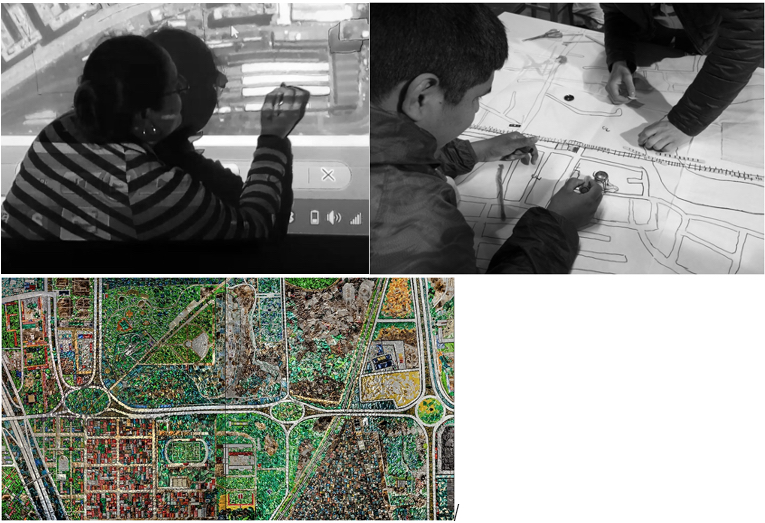
Session attendee, Jaime Jackson, Artist Director Salt Road and New Leaf from the United Kingdom, introduces us with an activity of Good Living as well as provides insight on Biophilic arts. Good Living: a co-produced artwork exploration of Traditional Ecological Knowledge (TEK) linking young people from indigenous communities with those living in cities in the UK, Argentina, and elsewhere. To collaboratively create content for a Virtual Reality artwork. Based on intrinsic nature-based wisdom in indigenous peoples, a live and lived experience of interdependency with nature. To creatively share indigenous knowledge as inspiration for art making.
Earth dreams, songs and storytelling are gifts for our participants to co-produce in response and build emotional resonance through art around the interdependency between humans and nature. It relates to biophilia part of the Biophilic City Network (biophilia means loving nature. Biophilic art challenges our perceived separation from the rest of nature.) As biophilic design integrates nature into our cities, biophilic art is a process that helps us presence a connection with our natural selves. By summoning the senses and sense experience, and becoming present in and with nature, a pause moment is created. This develops into a more discerning emotional awareness of the climate and ecological crisis. Creating a parity of engagement and creative opportunity for young people with different levels of knowledge – indigenous and otherwise.

What’s next?
The moderators of the session, Baiba Pruse and Cristina Flora as well as the rest of the organizing team, are grateful for the attention given by the participants and the continuity of the activities. As outlined at the end of the session, we foresee to work on an academic study based on the case studies presented as well as hope to bring the discussions further. We welcome more contributions to be presented as part of the upcoming study! Please, reach out to Baiba Pruse [baiba.pruse(@)unive.it] if you foresee that your study/case answers the central question of the session: where and how LEK appears in urban environments through artworks? We also welcome more examples through the interactive tool regarding LEK in the city through art: https://www.google.com/maps/d/u/1/edit?mid=18uN5NuYctWWElX2pBf-xJovUvacfrIcM&usp=sharing
We also thank the organizers of the Festival for the option to bring this diverse group together! And please, reach out to Baiba if you want to hear the full session through the recording.
Baiba Pruse, Marthe Derkzen, Eva Bubla, Ivan Greco, Ezequiel Filgueira Risso, Lindsay Campbell, Jaime Jackson, Julia Prakofjewa, Rick Hall, Lara Eva Bustamante, Colin D. Meurk, Nataliya Stryamets, Andra Simanova, Anna Varga, Cristina Flora
Venice, Arnhem, Bermingham, Buenos Aires, Budapest, Christchurch, New York, Nottingham, Pécs, Riga,
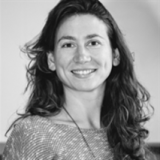
about the writer
Marthe Derkzen
Dr. Marthe Derkzen is a researcher and lecturer with the Health and Society chair group. She studies urban nature from a social justice perspective with an interest in climate adaptation, local food, healthy neighborhoods and stewardship of the commons.
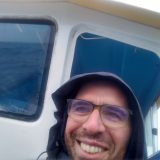
about the writer
Iván Greco
Economist from the University of Buenos Aires with a Master of Science in Sustainable Development from the University of Uppsala. Iván has participated in several projects, building local knowledge with vulnerable communities in Buenos Aires and Central Chile, which served as the foundations for the co-design of locally owned initiatives with economic and environmental impact.
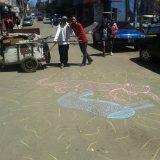
about the writer
Ezequiel Filgueira Risso
Creator and head of the Red ECCCO Foundation: for Education, Science, Community Cultures and Cooperation; whose program The Citizen Voice and its community art and culture days have been declared of cultural interest by the Legislature of the Autonomous City of Buenos Aires and the UNESCO Chair of Education for Peace and International Understanding.
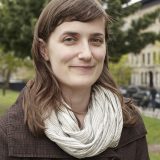
about the writer
Lindsay Campbell
Lindsay K. Campbell is a research social scientist with the USDA Forest Service. Her current research explores the dynamics of urban politics, stewardship, and sustainability policymaking.
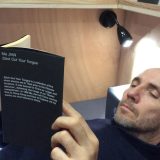
about the writer
Jaime Jackson
Jaime is a coordinator for Culture Declares Emergency, director of New Leaf Sustainability Ltd, Salt Road and member of Climate Museum UK. Jaime is a lead artist in the Biophilic City Network (Birmingham is a Biophilic City), he collaborates with dancers to make artworks, layering imagery from nature onto the costumes of the dancers to produce looped and layered installations.
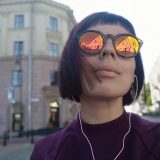
about the writer
Julia Prakofjewa
Currently a doctoral candidate in Environmental Sciences, her research interests include local ecological knowledge of useful plant diversity for healthcare, food security and subsistence. She continuously expands her expertise on digital environmental communication and social and cultural aspects of human-nature relationships.
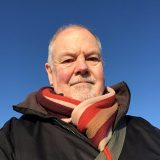
about the writer
Rick Hall
Rick is the founder of Ignite! an education charity that promotes creativity and curiosity. By encouraging children, young people and families to consider STEM subjects as innately creative, the charity works across learning disciplines with artists and scientists to reveal, discover and explore the connections between curiosity, creativity and community.
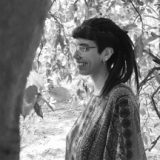
about the writer
Lara Eva Bustamante
Landscape planning and design professional. Looking to expand the limits of what she thinks the landscape is. Working on public policies for sustainable development and climate change mitigation. Studying art in cartographies (or cartographies in art). Collaborating in the participatory construction of spaces and knowledges in the city of Buenos Aires.
about the writer
Colin Meurk
Dr Colin Meurk, ONZM, is an Associate at Manaaki Whenua, a NZ government research institute specialising in characterisation, understanding and sustainable use of terrestrial resources. He holds adjunct positions at Canterbury and Lincoln Universities. His interests are applied biogeography, ecological restoration and design, landscape dynamics, urban ecology, conservation biology, and citizen science.
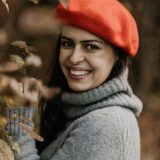
about the writer
Nataliya Stryamets
PhD in Forestry and Forest Sciences. Working with ethnobiology, sustainability issues, nature protection, climate change, non governmental organizations and rural development. Science and art promoter (working in museums), traveler, photographer and love to cook.
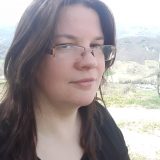
about the writer
Andra Simanova
PhD in folklore studies (traditional ecological knowledge and wild plants in Latvia and Eastern Europe). Activities in non-governmental organizations regarding environmental and cultural education. Development of educational programs combining traditional ecological knowledge and environmental education, nature art and crafts.
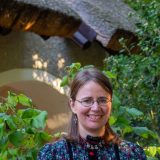
about the writer
Anna Varga
Anna Varga is a biologist, a forest pedagogist and a weaver. In her PhD, she worked on ethnobiology, environmental history and vegetation science of forest grazing and wood pastures. She developed local and traditional, and art based environmental education projects about wood pastures and local protected sites. S
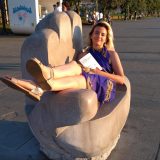
about the writer
Cristina Flora
BS in Chemistry and current MS student in Environmental Sciences. Art lover, science communication amateur, passionate about all the forms of collaboration between art, science and technology.

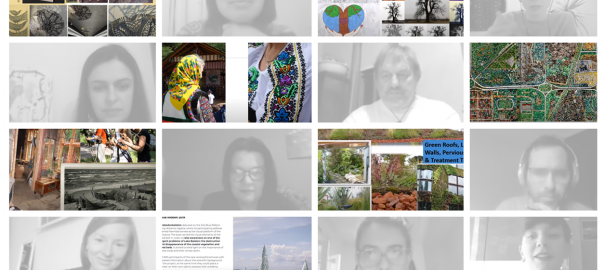






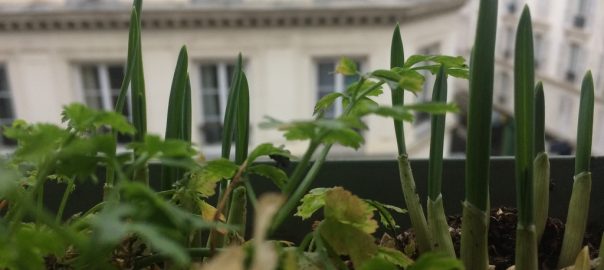
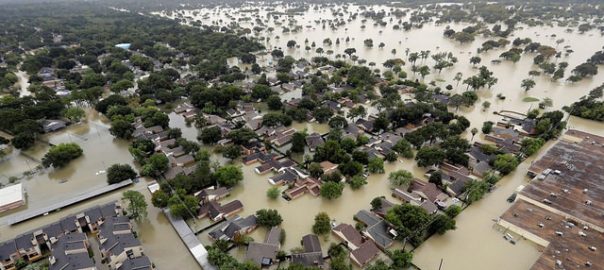
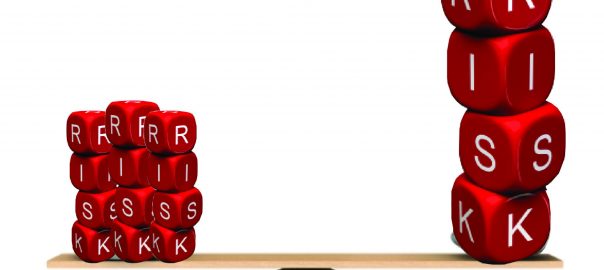
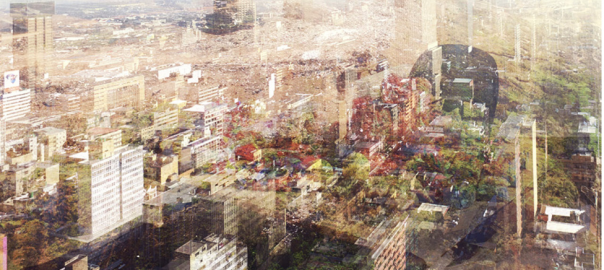
3 Comments
Join our conversation